WOC 369
Page 369
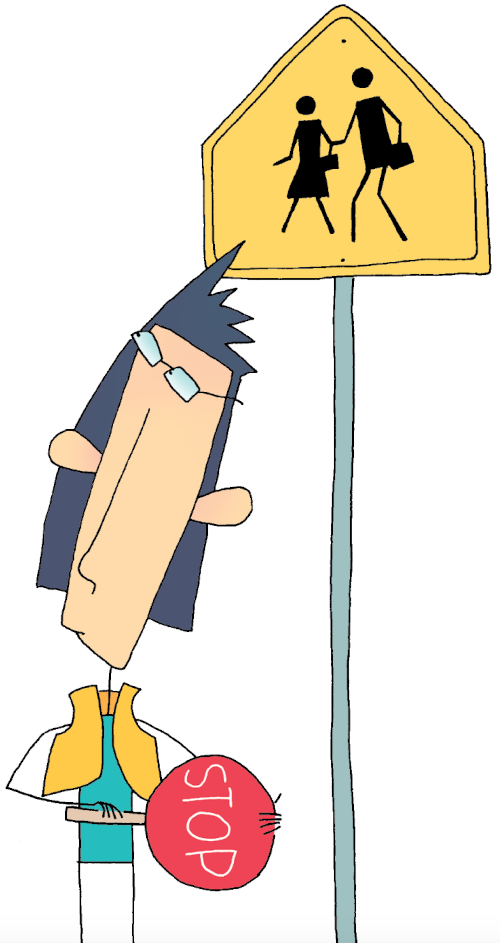
Reading Nonfiction
Nonfiction tells us about our world. Nonfiction might be a sign that simply says, “Stop,” or another that uses a picture to indicate a cross-walk. On the other hand, it might be a 1,000-page history of the Western World.
Obviously, you can’t read such a history the same way that you read a stop sign. Even individual pages require a more careful approach. By scanning, evaluating, skimming, study-reading, and interacting, you’ll not just read but understand the nonfiction you encounter.
Different nonfiction uses different organizational patterns. Recognizing them helps you keep the ideas sorted as you read, take notes, and review what you’ve learned.
What’s Ahead
WOC 370
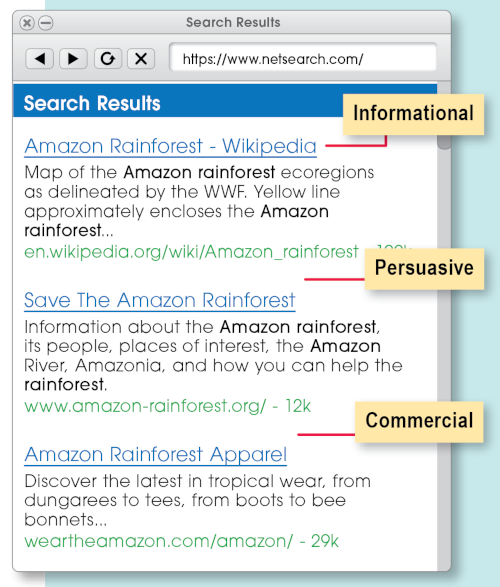
Page 370
Reading on the Internet
The Internet requires you to read at different speeds, for different purposes. Here are some of the types of reading you need to do.
■ Scanning
When you first conduct a search, scan the results page, looking for websites that may have the information you need. Read the heading and the first few lines of each suggested site to make sure it matches your subject and purpose. For example, this search for “Amazon rainforest” produced three top sites—one informational, one persuasive, and one commercial.

■ Evaluating
Once you select a site, quickly evaluate it to make sure it matches your needs. Ask yourself the following questions:
_____ Does the site look professional?
_____ Is the site free of obvious errors?
_____ Has the site been recently updated?
_____ Does the text seem fair and balanced?
_____ Do the images seem fair and balanced?
_____ Is the source clear?
Helpful Hint
Education (.edu), organization (.org), and government (.gov) sites are often more reliable than commercial (.com) sites.
WOC 371
Page 371

■ Skimming
After you establish the reliability of a site, skim the contents, focusing on
- headings,
- images,
- links, and
- first and last sentences.
Skimming helps you preview the site. The cues above help you understand what information is available and how it is organized.
■ Study-Reading
Now you’re ready to read the material with more care. Do the following:
- Think before you read.
- Pause during your reading.
- Reflect after reading.
For specific study-reading strategies, see pages 372–385.
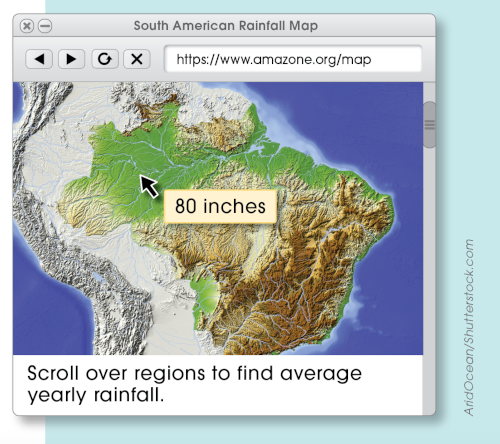
■ Interacting
Many pages provide information in interactive forms, including videos, podcasts, surveys, contests, scavenger hunts, puzzles, games, and so on. For example, by scrolling over a graphic, you may find additional information. So be sure to explore the interactive elements.
WOC 372
Page 372
Study-Reading Strategies
When you improve your nonfiction reading skills, you save time, learn more easily, and get better grades. You can use the “Before, During, and After” strategy to help you effectively read nonfiction in social studies, science, or any other subject.
Before, During, and After
To closely read nonfiction, think about the topic “Before, During, and After” your reading.
■ Think Before Reading
- Ask yourself what you think you’ll learn from the reading.
- Skim the text to get a general idea of what it’s about. (Learn more about “skimming” on page 371.)
■ Pause During Reading
- Pick out the key sentences in each paragraph.
- Take reading notes. Jot down key facts, important definitions, and any questions you may have. (See “Taking Reading Notes” on page 467.)
- Reread difficult parts out loud.
- Stop periodically to repeat key points to yourself to make sure you understand what you’re reading.
■ Reflect After Reading
- Review your reading notes and think about what you have learned.
- List the key points, or choose a graphic organizer to fill in the main ideas from the reading.
- Summarize the reading in your own words, perhaps as an entry in a learning log.
Helpful Hint
Review “Taking Reading Notes” on page 467 for more tips on reading to learn.
WOC 373
Page 373
KWL
Another strategy you can use is “KWL.” KWL is an effective study-reading strategy for when you already know something about the topic. KWL stands for what I “Know,” what I “Want” to know, and what I have “Learned.”
How to Use a KWL Chart
Download a blank KWL chart to complete.
- Write the topic of your reading at the top of a sheet of paper. Then divide the sheet into three columns and label them K, W, and L.
- List what you already know in the K column.
- Fill in the W column with questions you want to explore.
- When you finish reading, fill in the L column with information you learned or still hope to learn.

WOC 374
Page 374
Patterns of Nonfiction
Knowing the common patterns of nonfiction makes it easier to understand your assigned reading. Six of these patterns are reviewed in this chapter: description, main idea/supporting details, comparison/contrast, chronological order, cause and effect, and process.
Description
This page from a website about earth science describes a geologic event called subduction. The page uses metaphors, relationships, and definitions to describe the event.
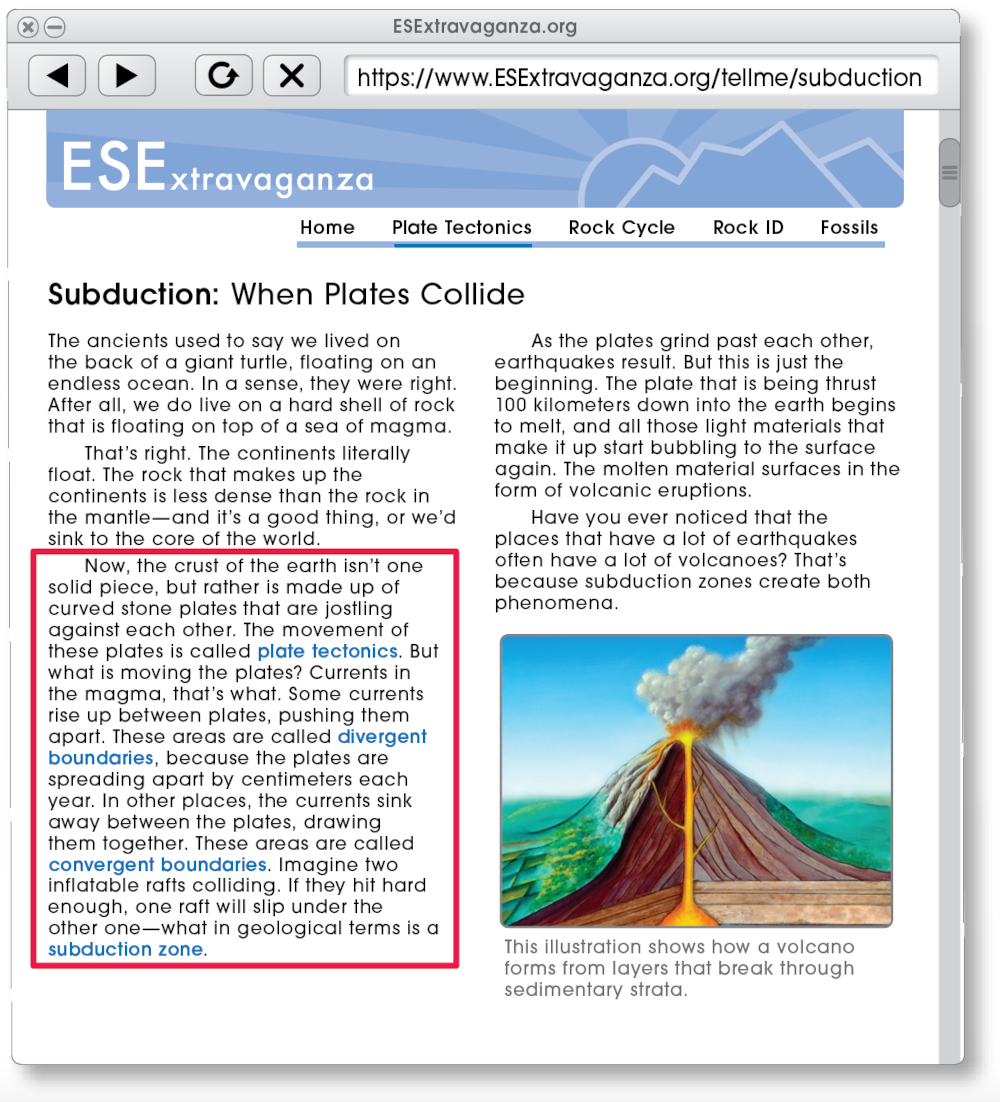
Study-Reading
As you read, notice important information you will want to record.

WOC 375
Page 375
Web ■ As you read (or after you read) consider using a graphic organizer to help you organize your thoughts. You can use a web to help you organize the important information that follows a description pattern like the sample below.
Note Taking
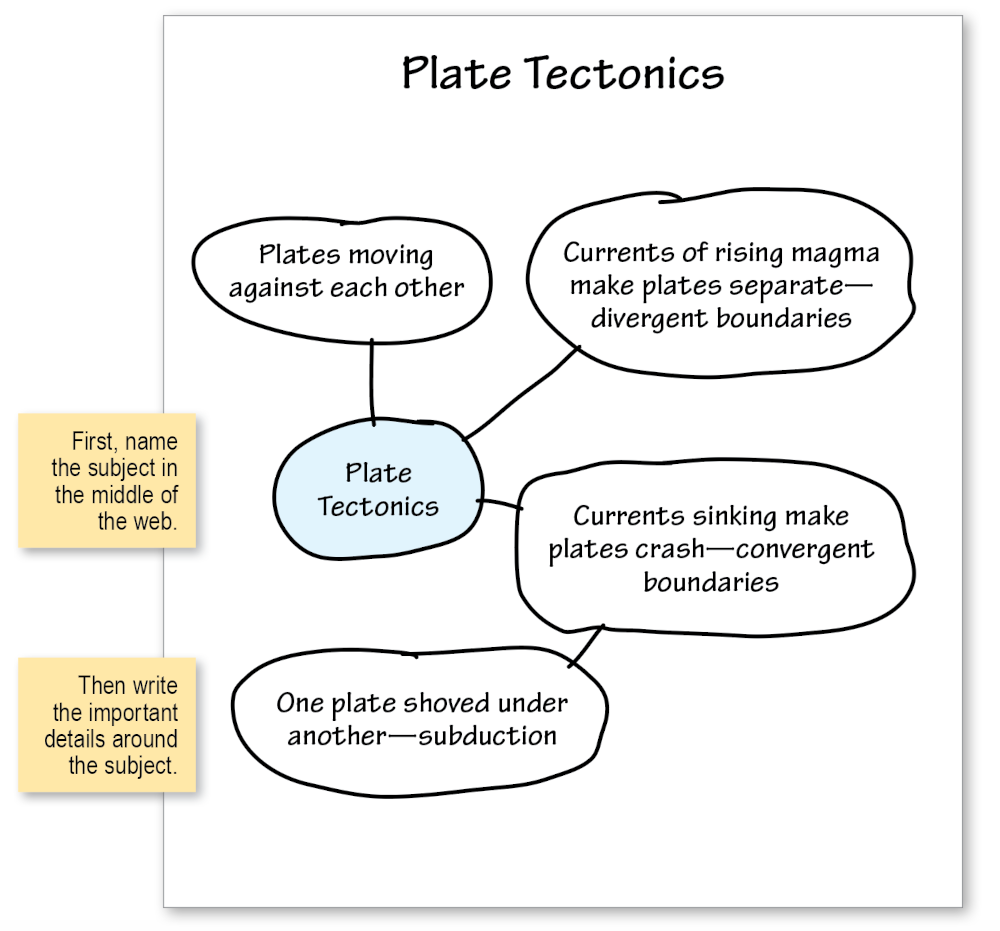
WOC 376
Page 376
Main Idea/Supporting Details
This information from a website about tae kwon do follows the main idea/supporting details pattern. The heading at the top of the page introduces the subject, the first couple of sentences share the main idea, and the rest of the page gives details that support this idea.
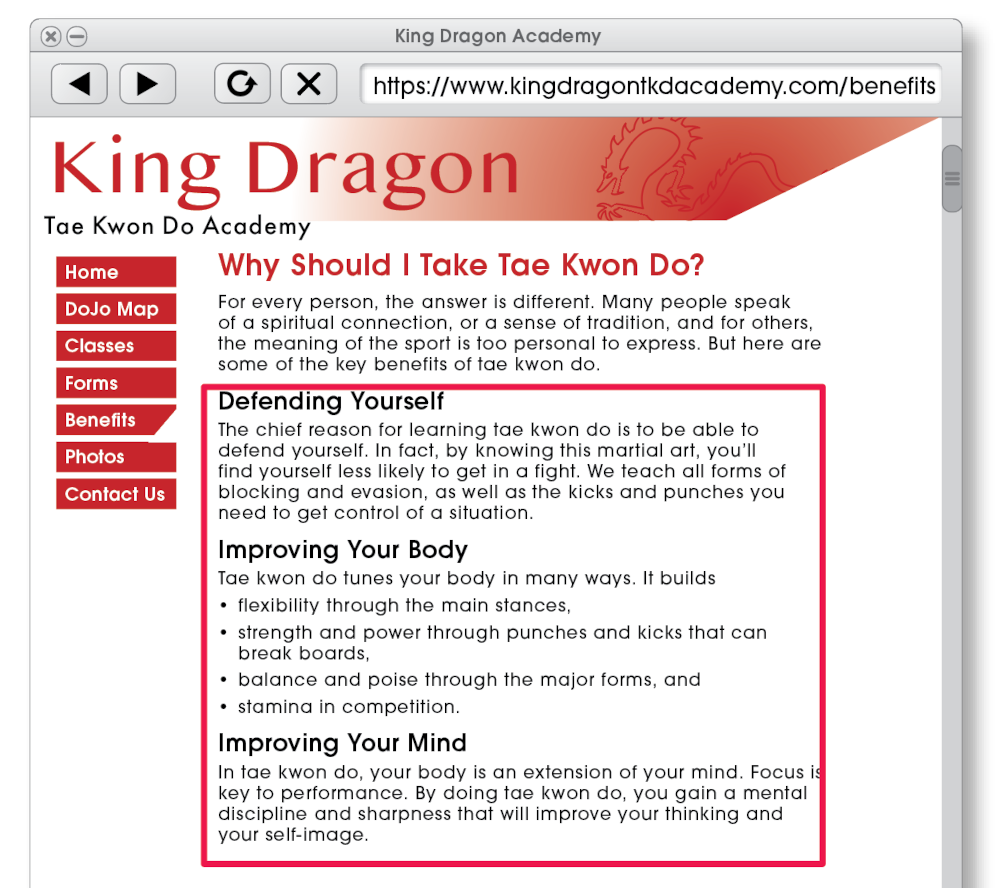
Study-Reading
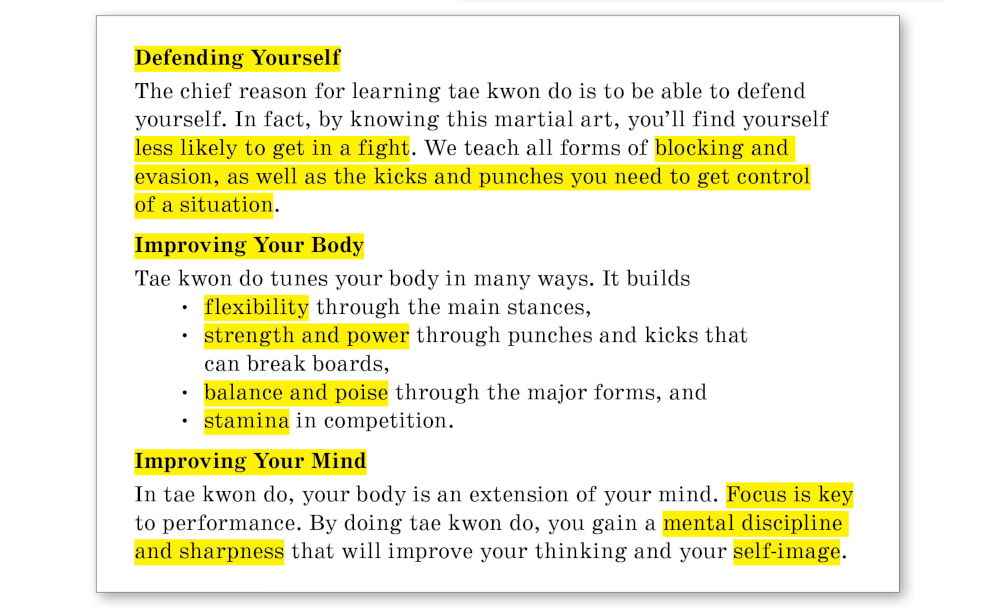
WOC 377
Page 377
Table Organizer ■ When a selection follows the main idea/supporting details pattern, you can use a table organizer to help you sort out the important details.
Note Taking
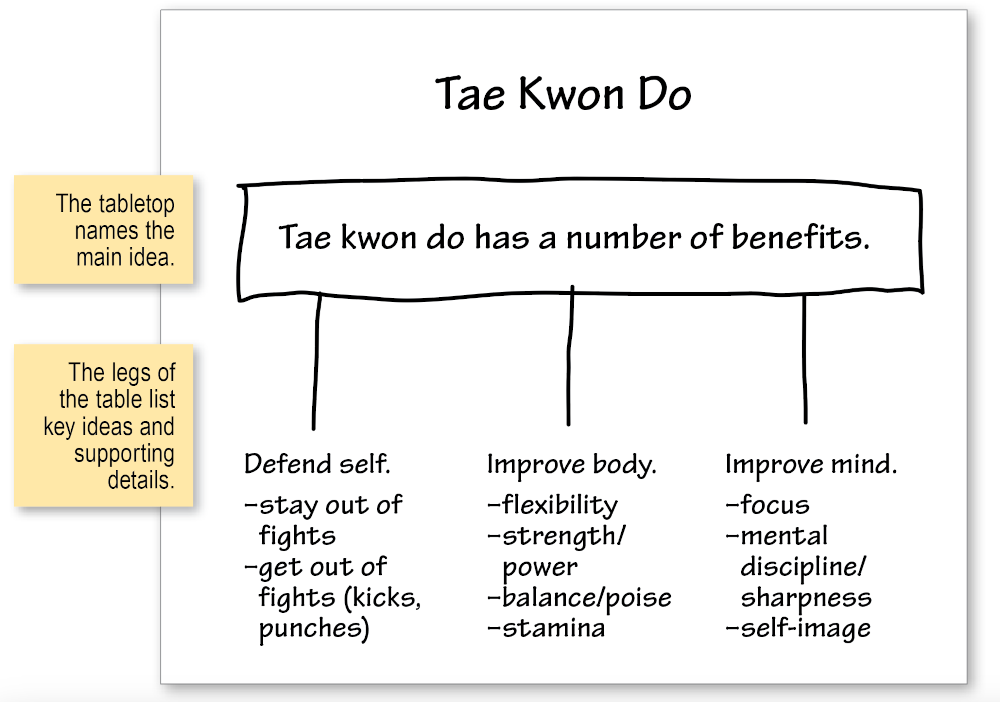
WOC 378
Page 378
Comparison/Contrast
Comparison/contrast is another important pattern of nonfiction. The information below, from an astronomy website, compares Venus and Earth. The first paragraph in the excerpt describes similarities between the planets. The second paragraph focuses on the differences.

Study-Reading

WOC 379
Page 379
Venn Diagram ■ When your reading assignment follows the comparison/contrast pattern, you can use a Venn diagram to organize important information that compares and contrasts two subjects.
Note Taking
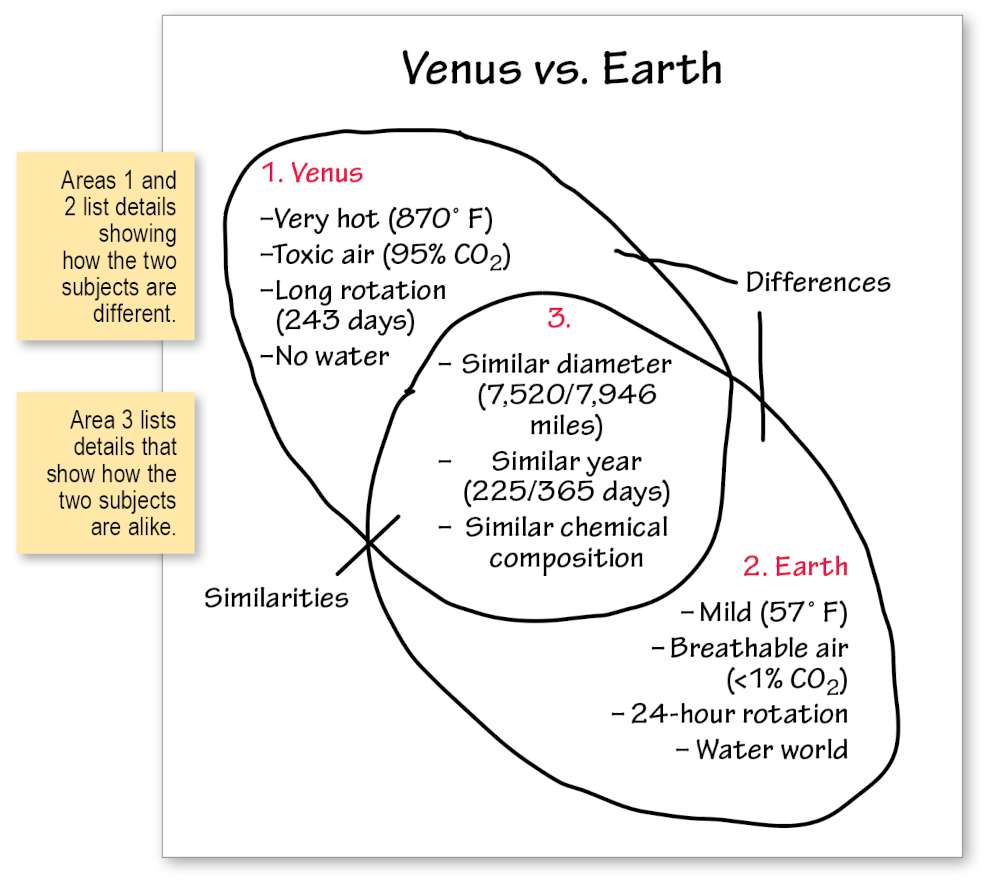
WOC 380
Page 380
Chronological Order
This article taken from a history textbook follows the chronological (time order) pattern of organization. The article gives the basic facts about the Lewis and Clark expedition, which explored the western area that would become part of the United States.
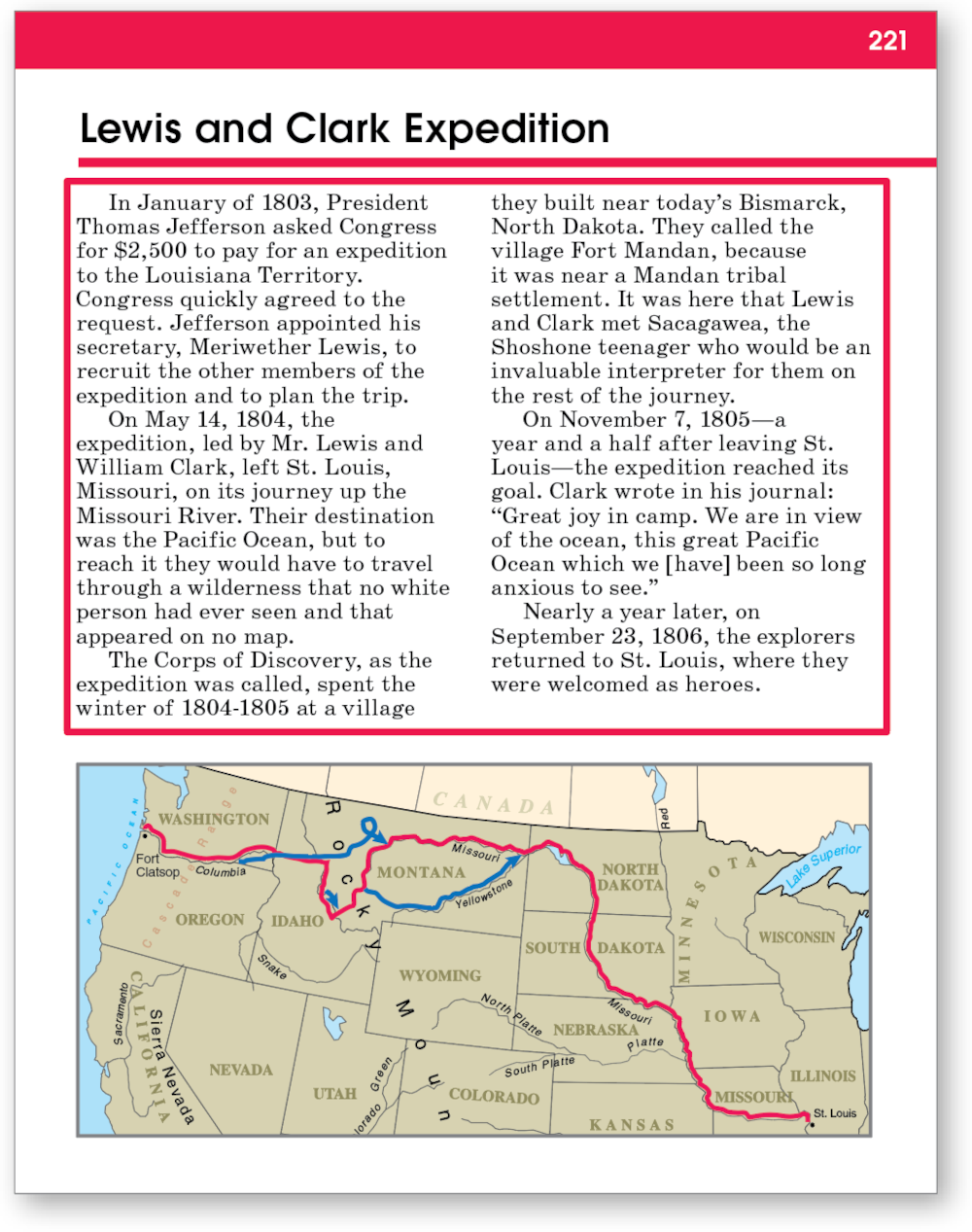
Study-Reading

WOC 381
Page 381
Time Line ■ A time line is a quick and easy way to show the chronological order of events in your reading assignment.
Note Taking
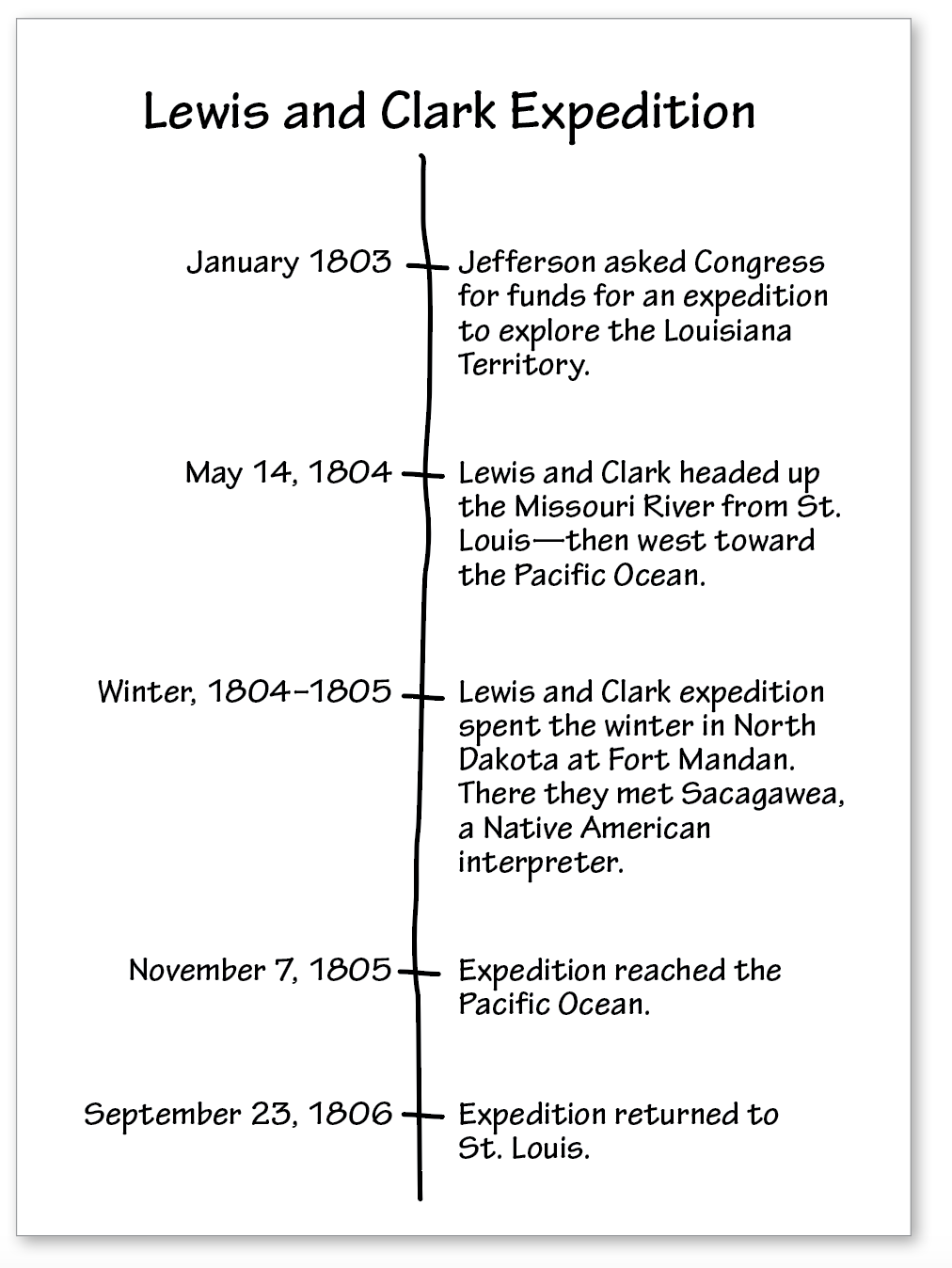
WOC 382
Page 382
Cause and Effect
The information below is from a magazine article about Easter Island. As you’ll see, it follows the cause and effect pattern. It discusses a change in the food chain that may explain why the ancient Easter Islanders deserted their home.
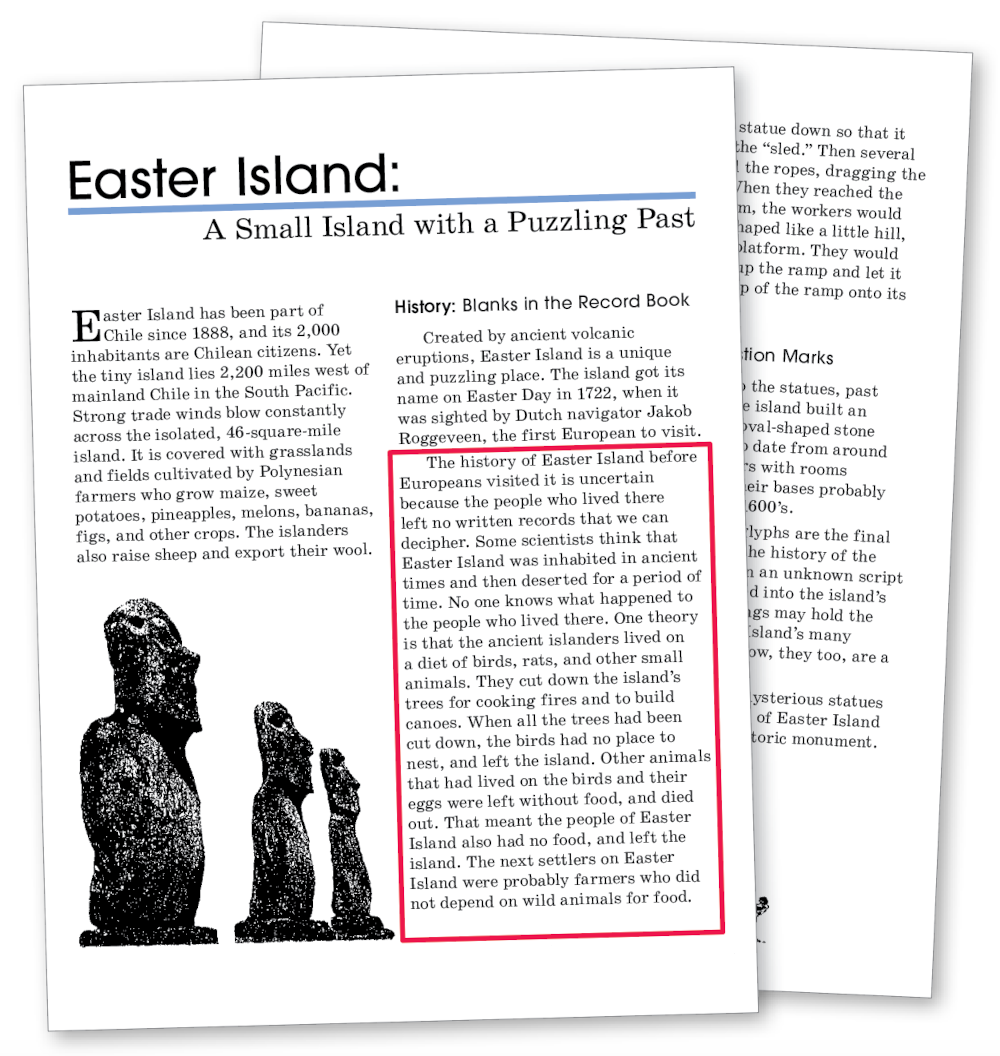
Study-Reading

WOC 383
Page 383
Cause-Effect Organizer ■ You can use a cause-effect organizer to keep track of important information that explains causes and effects.
Note Taking

WOC 384
Page 384
Process
The text in this later part of the Easter Island article (page 382) follows a process pattern. It describes in detail how some scientists think the large statues of Easter Island were built over time.
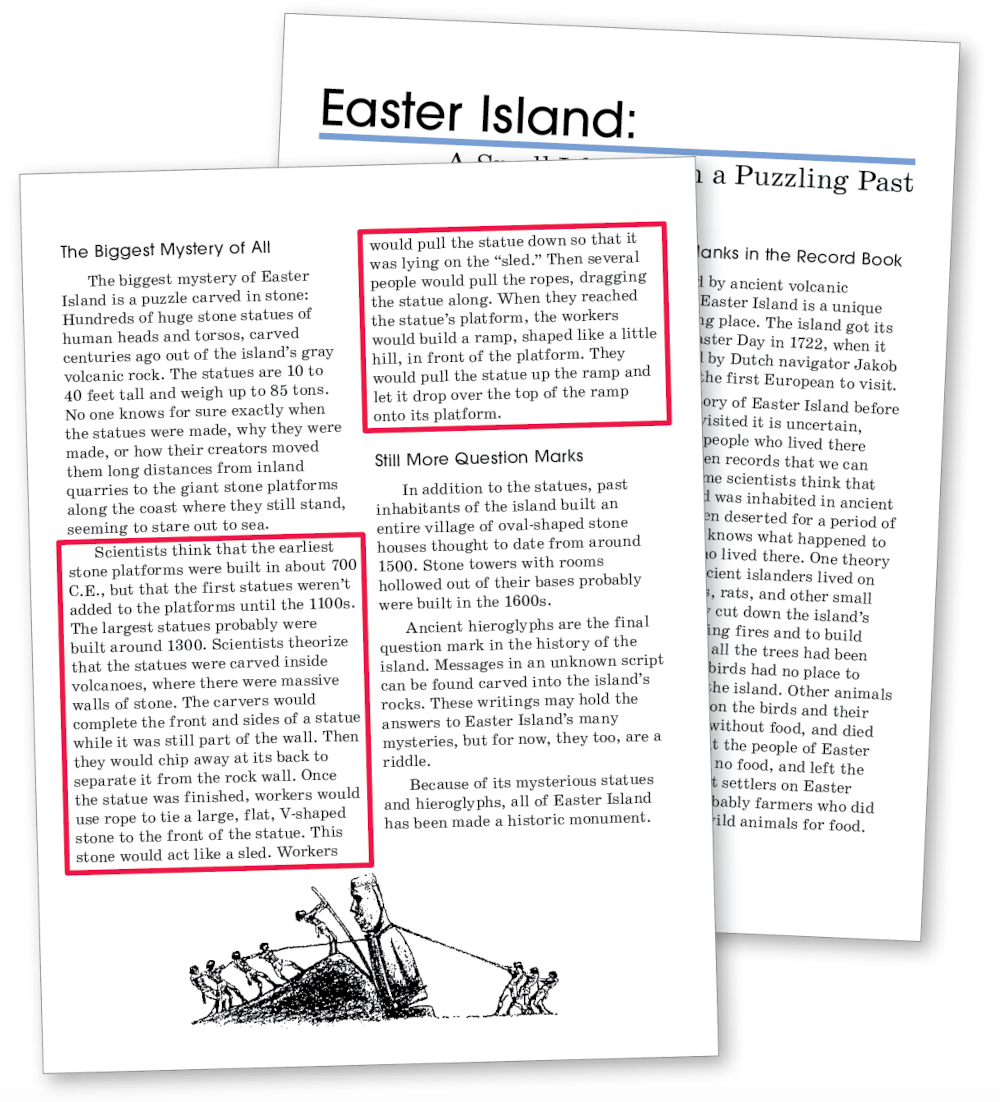
Study-Reading
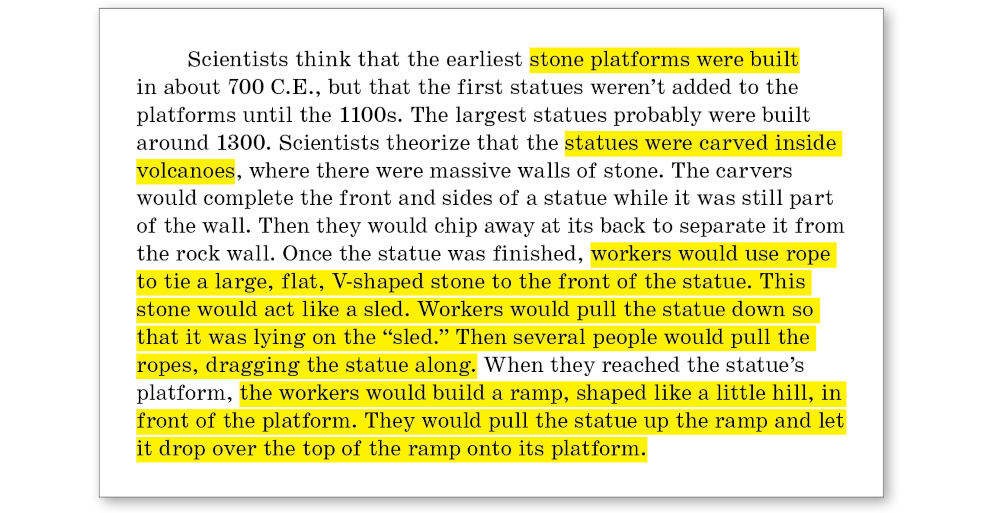
WOC 385
Page 385
Process List ■ Important information that follows the process pattern can be arranged in a list or a circle.
Note Taking
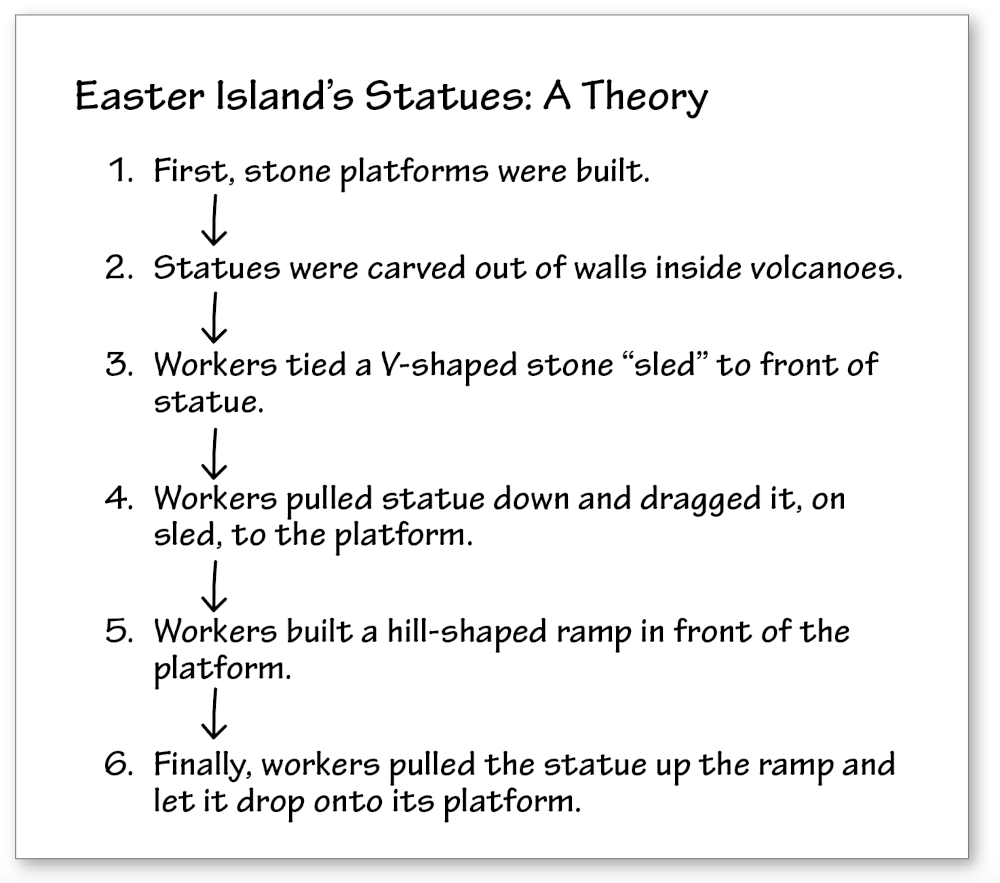
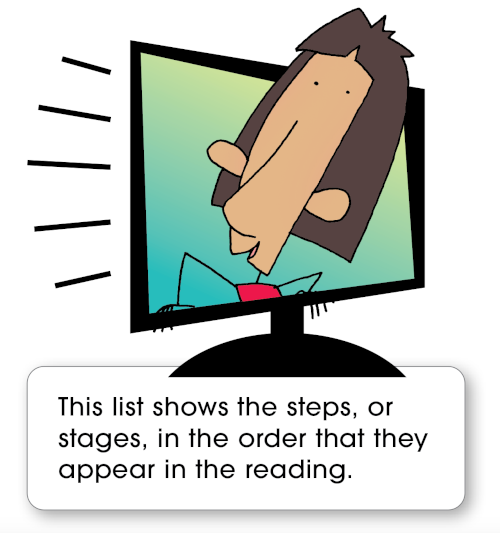
WOC 386
Page 386
Reading Nonfiction Review
When you need to read nonfiction for school assignments, follow these steps.
- Search: Search online using keywords about the subject, author, or title.
- Scan: Quickly check the results of your search, reading the heading and first few lines to find a source that fits the subject and purpose of your investigation.
- Evaluate: After selecting a source, quickly review it to see if it meets your needs and is reliable. Ask the following questions:
- Where does the information come from?
- Is it up to date?
- Is the information presented clearly?
- Is it fair and balanced?
- What is the author’s purpose?
- Skim: Quickly skim the headings, links, images, captions, and first and last sentences of a paragraph or page to get the overall sense of the material it contains.
- Study-Read: Carefully read the whole article or section, using the “Before, During, and After” or “KWL” strategy (see pages 372–373). Take notes. If it is helpful, use a graphic organizer to plot out the main points of the piece (see pages 374–385).
- Interact: Try interactive features and follow links to see where they lead.